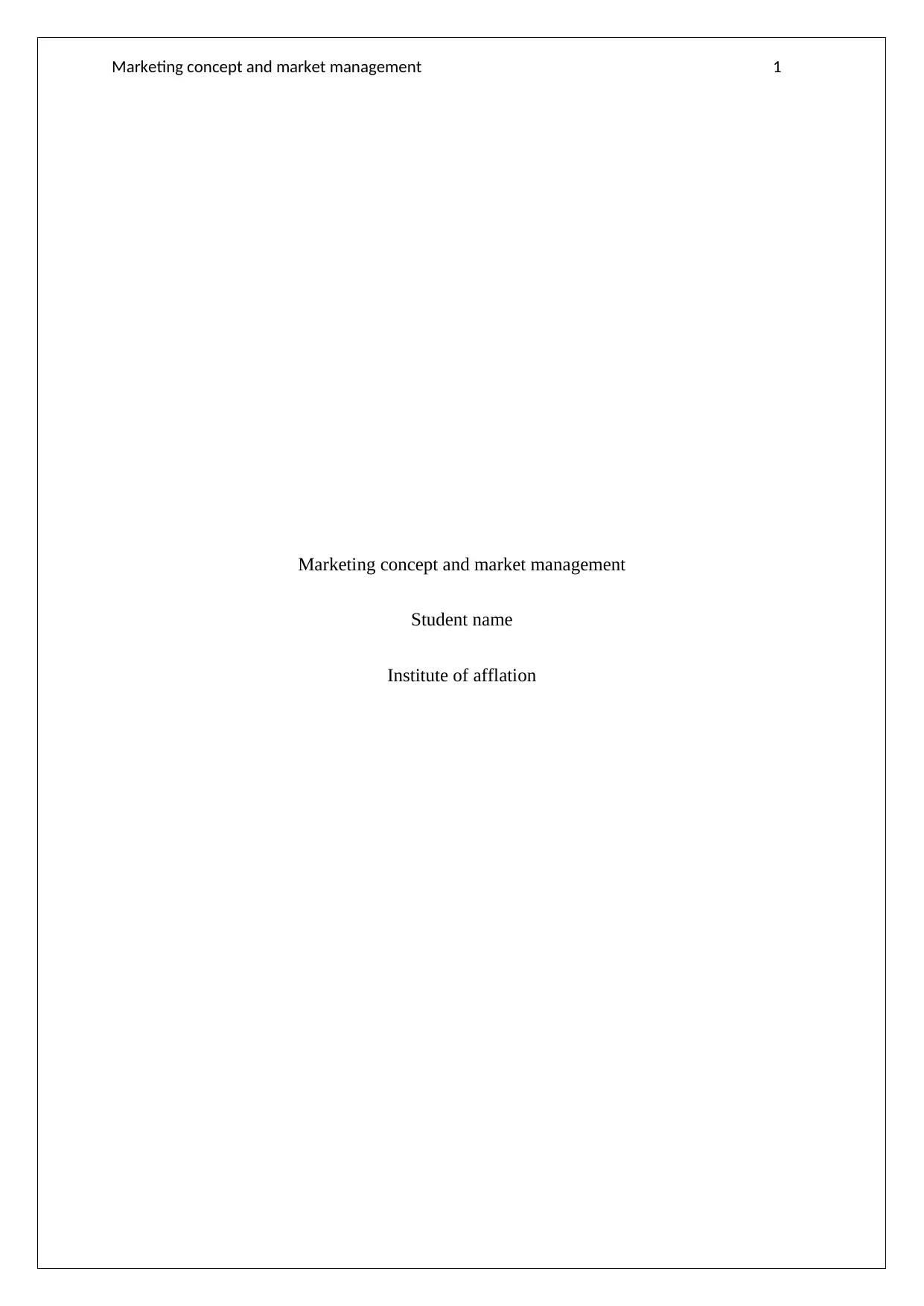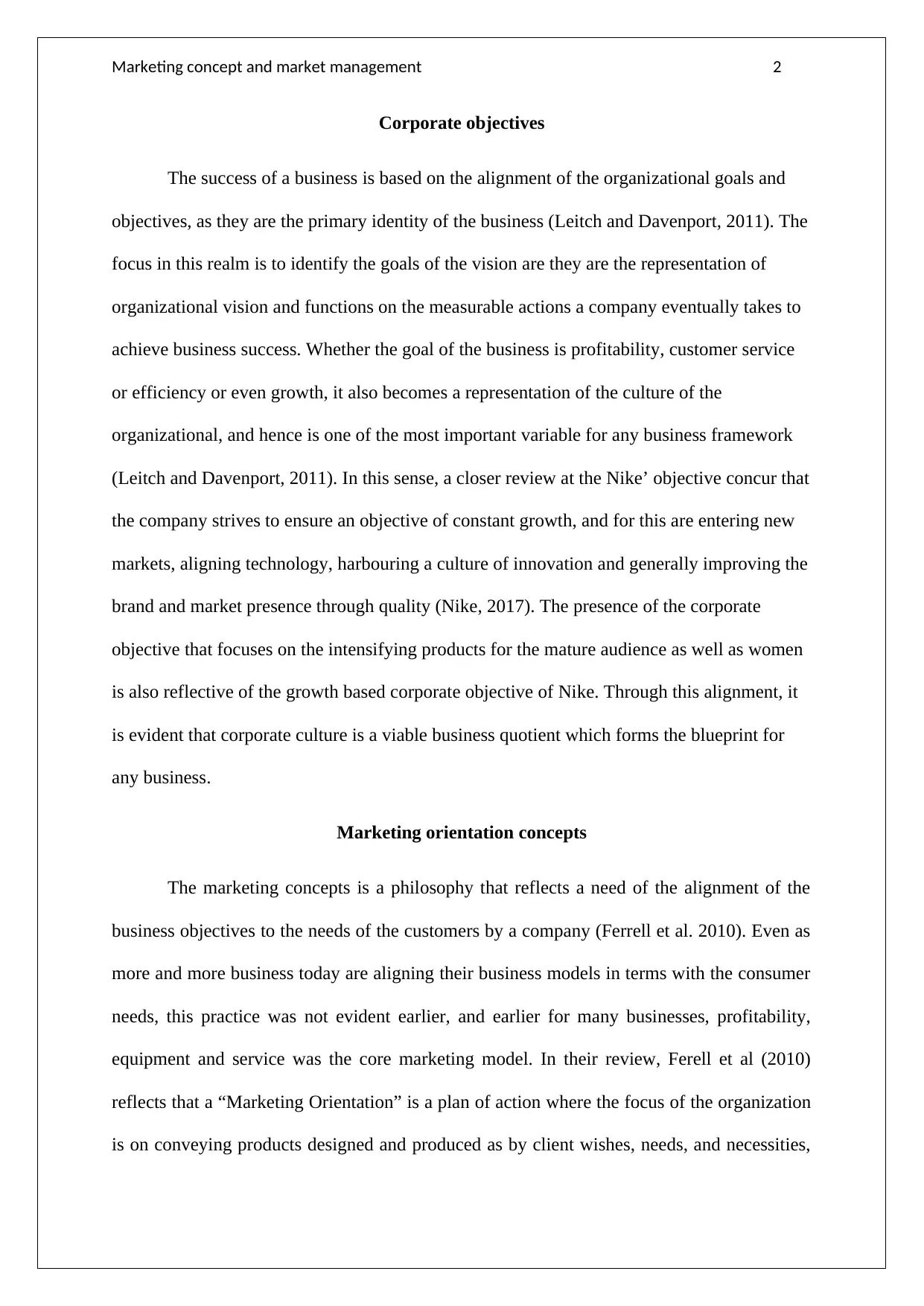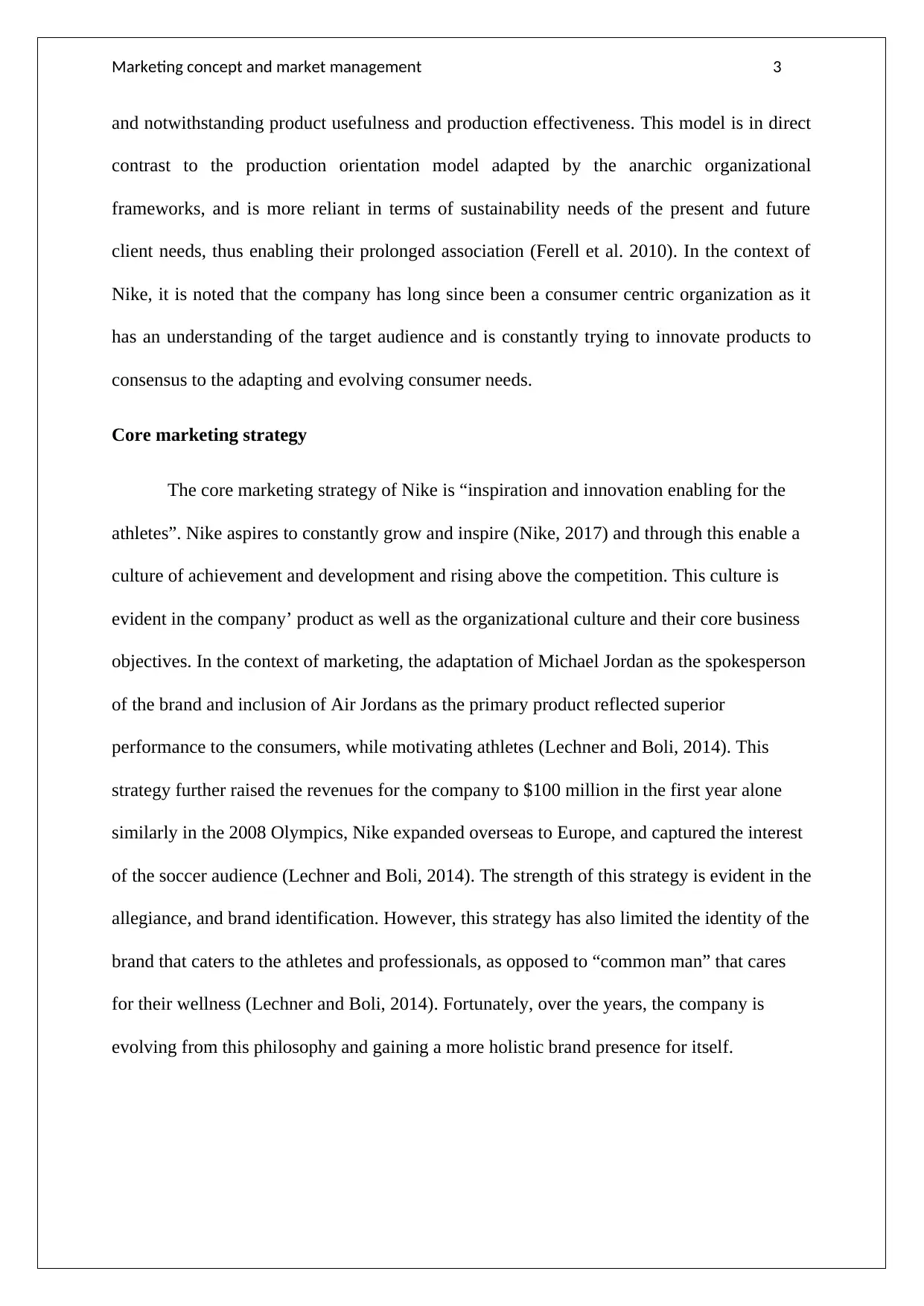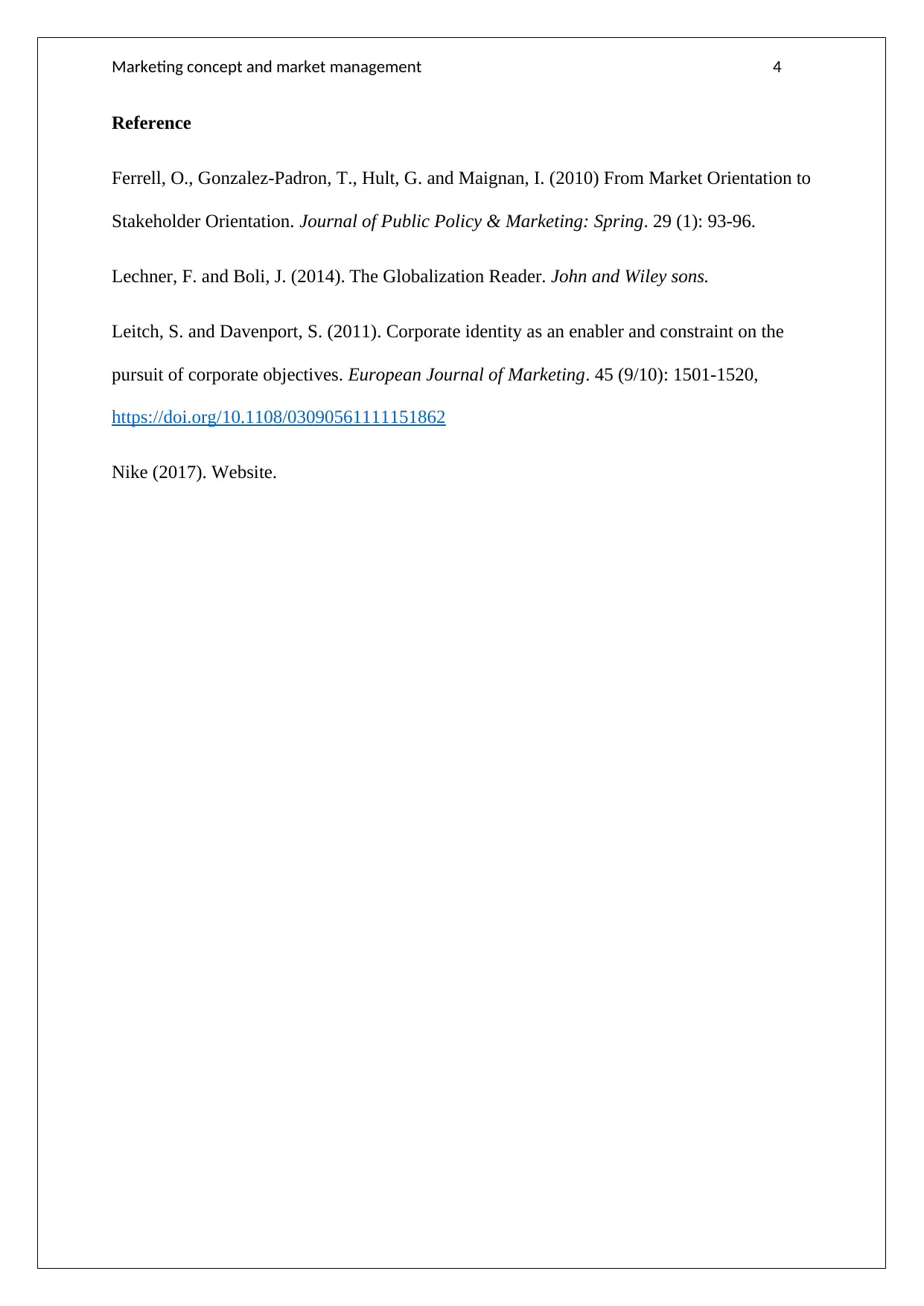Marketing Concept and Market Management Analysis: Nike Report
VerifiedAdded on 2020/03/04
|4
|825
|47
Report
AI Summary
This report provides an analysis of marketing concepts and market management, using Nike as a case study. It begins by examining corporate objectives, emphasizing the alignment of organizational goals with business success, and highlights Nike's focus on constant growth, market expansion, and ...

Marketing concept and market management 1
Marketing concept and market management
Student name
Institute of afflation
Marketing concept and market management
Student name
Institute of afflation
Paraphrase This Document
Need a fresh take? Get an instant paraphrase of this document with our AI Paraphraser

Marketing concept and market management 2
Corporate objectives
The success of a business is based on the alignment of the organizational goals and
objectives, as they are the primary identity of the business (Leitch and Davenport, 2011). The
focus in this realm is to identify the goals of the vision are they are the representation of
organizational vision and functions on the measurable actions a company eventually takes to
achieve business success. Whether the goal of the business is profitability, customer service
or efficiency or even growth, it also becomes a representation of the culture of the
organizational, and hence is one of the most important variable for any business framework
(Leitch and Davenport, 2011). In this sense, a closer review at the Nike’ objective concur that
the company strives to ensure an objective of constant growth, and for this are entering new
markets, aligning technology, harbouring a culture of innovation and generally improving the
brand and market presence through quality (Nike, 2017). The presence of the corporate
objective that focuses on the intensifying products for the mature audience as well as women
is also reflective of the growth based corporate objective of Nike. Through this alignment, it
is evident that corporate culture is a viable business quotient which forms the blueprint for
any business.
Marketing orientation concepts
The marketing concepts is a philosophy that reflects a need of the alignment of the
business objectives to the needs of the customers by a company (Ferrell et al. 2010). Even as
more and more business today are aligning their business models in terms with the consumer
needs, this practice was not evident earlier, and earlier for many businesses, profitability,
equipment and service was the core marketing model. In their review, Ferell et al (2010)
reflects that a “Marketing Orientation” is a plan of action where the focus of the organization
is on conveying products designed and produced as by client wishes, needs, and necessities,
Corporate objectives
The success of a business is based on the alignment of the organizational goals and
objectives, as they are the primary identity of the business (Leitch and Davenport, 2011). The
focus in this realm is to identify the goals of the vision are they are the representation of
organizational vision and functions on the measurable actions a company eventually takes to
achieve business success. Whether the goal of the business is profitability, customer service
or efficiency or even growth, it also becomes a representation of the culture of the
organizational, and hence is one of the most important variable for any business framework
(Leitch and Davenport, 2011). In this sense, a closer review at the Nike’ objective concur that
the company strives to ensure an objective of constant growth, and for this are entering new
markets, aligning technology, harbouring a culture of innovation and generally improving the
brand and market presence through quality (Nike, 2017). The presence of the corporate
objective that focuses on the intensifying products for the mature audience as well as women
is also reflective of the growth based corporate objective of Nike. Through this alignment, it
is evident that corporate culture is a viable business quotient which forms the blueprint for
any business.
Marketing orientation concepts
The marketing concepts is a philosophy that reflects a need of the alignment of the
business objectives to the needs of the customers by a company (Ferrell et al. 2010). Even as
more and more business today are aligning their business models in terms with the consumer
needs, this practice was not evident earlier, and earlier for many businesses, profitability,
equipment and service was the core marketing model. In their review, Ferell et al (2010)
reflects that a “Marketing Orientation” is a plan of action where the focus of the organization
is on conveying products designed and produced as by client wishes, needs, and necessities,

Marketing concept and market management 3
and notwithstanding product usefulness and production effectiveness. This model is in direct
contrast to the production orientation model adapted by the anarchic organizational
frameworks, and is more reliant in terms of sustainability needs of the present and future
client needs, thus enabling their prolonged association (Ferell et al. 2010). In the context of
Nike, it is noted that the company has long since been a consumer centric organization as it
has an understanding of the target audience and is constantly trying to innovate products to
consensus to the adapting and evolving consumer needs.
Core marketing strategy
The core marketing strategy of Nike is “inspiration and innovation enabling for the
athletes”. Nike aspires to constantly grow and inspire (Nike, 2017) and through this enable a
culture of achievement and development and rising above the competition. This culture is
evident in the company’ product as well as the organizational culture and their core business
objectives. In the context of marketing, the adaptation of Michael Jordan as the spokesperson
of the brand and inclusion of Air Jordans as the primary product reflected superior
performance to the consumers, while motivating athletes (Lechner and Boli, 2014). This
strategy further raised the revenues for the company to $100 million in the first year alone
similarly in the 2008 Olympics, Nike expanded overseas to Europe, and captured the interest
of the soccer audience (Lechner and Boli, 2014). The strength of this strategy is evident in the
allegiance, and brand identification. However, this strategy has also limited the identity of the
brand that caters to the athletes and professionals, as opposed to “common man” that cares
for their wellness (Lechner and Boli, 2014). Fortunately, over the years, the company is
evolving from this philosophy and gaining a more holistic brand presence for itself.
and notwithstanding product usefulness and production effectiveness. This model is in direct
contrast to the production orientation model adapted by the anarchic organizational
frameworks, and is more reliant in terms of sustainability needs of the present and future
client needs, thus enabling their prolonged association (Ferell et al. 2010). In the context of
Nike, it is noted that the company has long since been a consumer centric organization as it
has an understanding of the target audience and is constantly trying to innovate products to
consensus to the adapting and evolving consumer needs.
Core marketing strategy
The core marketing strategy of Nike is “inspiration and innovation enabling for the
athletes”. Nike aspires to constantly grow and inspire (Nike, 2017) and through this enable a
culture of achievement and development and rising above the competition. This culture is
evident in the company’ product as well as the organizational culture and their core business
objectives. In the context of marketing, the adaptation of Michael Jordan as the spokesperson
of the brand and inclusion of Air Jordans as the primary product reflected superior
performance to the consumers, while motivating athletes (Lechner and Boli, 2014). This
strategy further raised the revenues for the company to $100 million in the first year alone
similarly in the 2008 Olympics, Nike expanded overseas to Europe, and captured the interest
of the soccer audience (Lechner and Boli, 2014). The strength of this strategy is evident in the
allegiance, and brand identification. However, this strategy has also limited the identity of the
brand that caters to the athletes and professionals, as opposed to “common man” that cares
for their wellness (Lechner and Boli, 2014). Fortunately, over the years, the company is
evolving from this philosophy and gaining a more holistic brand presence for itself.
You're viewing a preview
Unlock full access by subscribing today!

Marketing concept and market management 4
Reference
Ferrell, O., Gonzalez-Padron, T., Hult, G. and Maignan, I. (2010) From Market Orientation to
Stakeholder Orientation. Journal of Public Policy & Marketing: Spring. 29 (1): 93-96.
Lechner, F. and Boli, J. (2014). The Globalization Reader. John and Wiley sons.
Leitch, S. and Davenport, S. (2011). Corporate identity as an enabler and constraint on the
pursuit of corporate objectives. European Journal of Marketing. 45 (9/10): 1501-1520,
https://doi.org/10.1108/03090561111151862
Nike (2017). Website.
Reference
Ferrell, O., Gonzalez-Padron, T., Hult, G. and Maignan, I. (2010) From Market Orientation to
Stakeholder Orientation. Journal of Public Policy & Marketing: Spring. 29 (1): 93-96.
Lechner, F. and Boli, J. (2014). The Globalization Reader. John and Wiley sons.
Leitch, S. and Davenport, S. (2011). Corporate identity as an enabler and constraint on the
pursuit of corporate objectives. European Journal of Marketing. 45 (9/10): 1501-1520,
https://doi.org/10.1108/03090561111151862
Nike (2017). Website.
1 out of 4
Your All-in-One AI-Powered Toolkit for Academic Success.
+13062052269
info@desklib.com
Available 24*7 on WhatsApp / Email
![[object Object]](/_next/static/media/star-bottom.7253800d.svg)
Unlock your academic potential
© 2024 | Zucol Services PVT LTD | All rights reserved.


